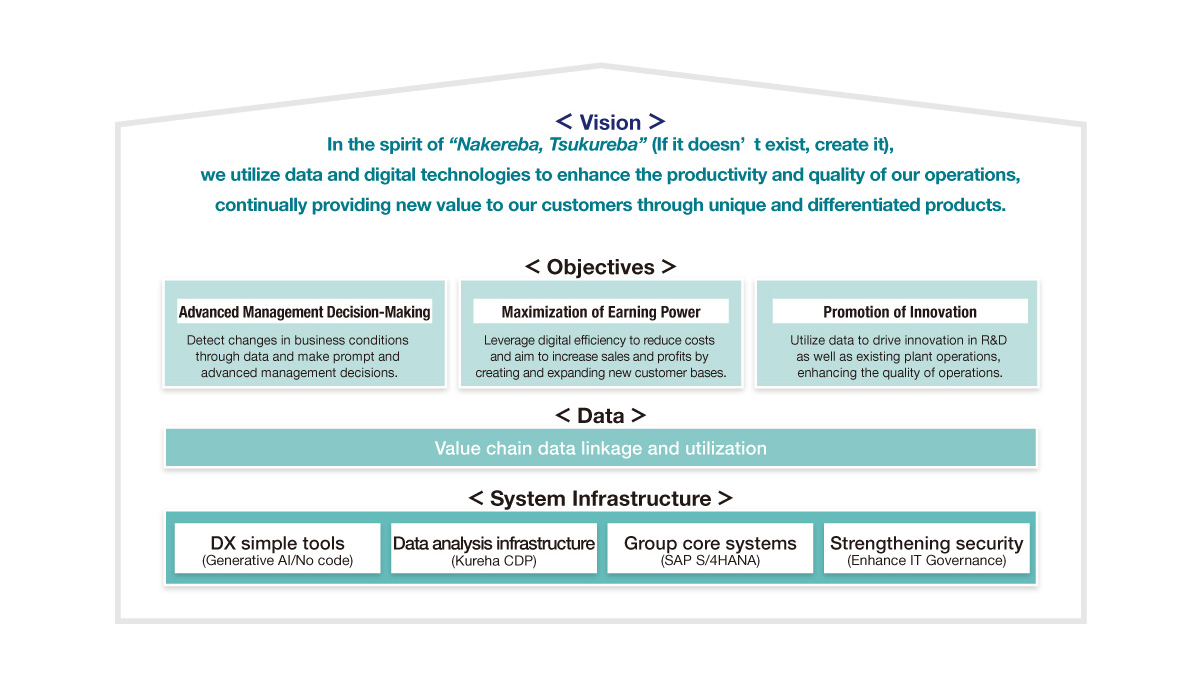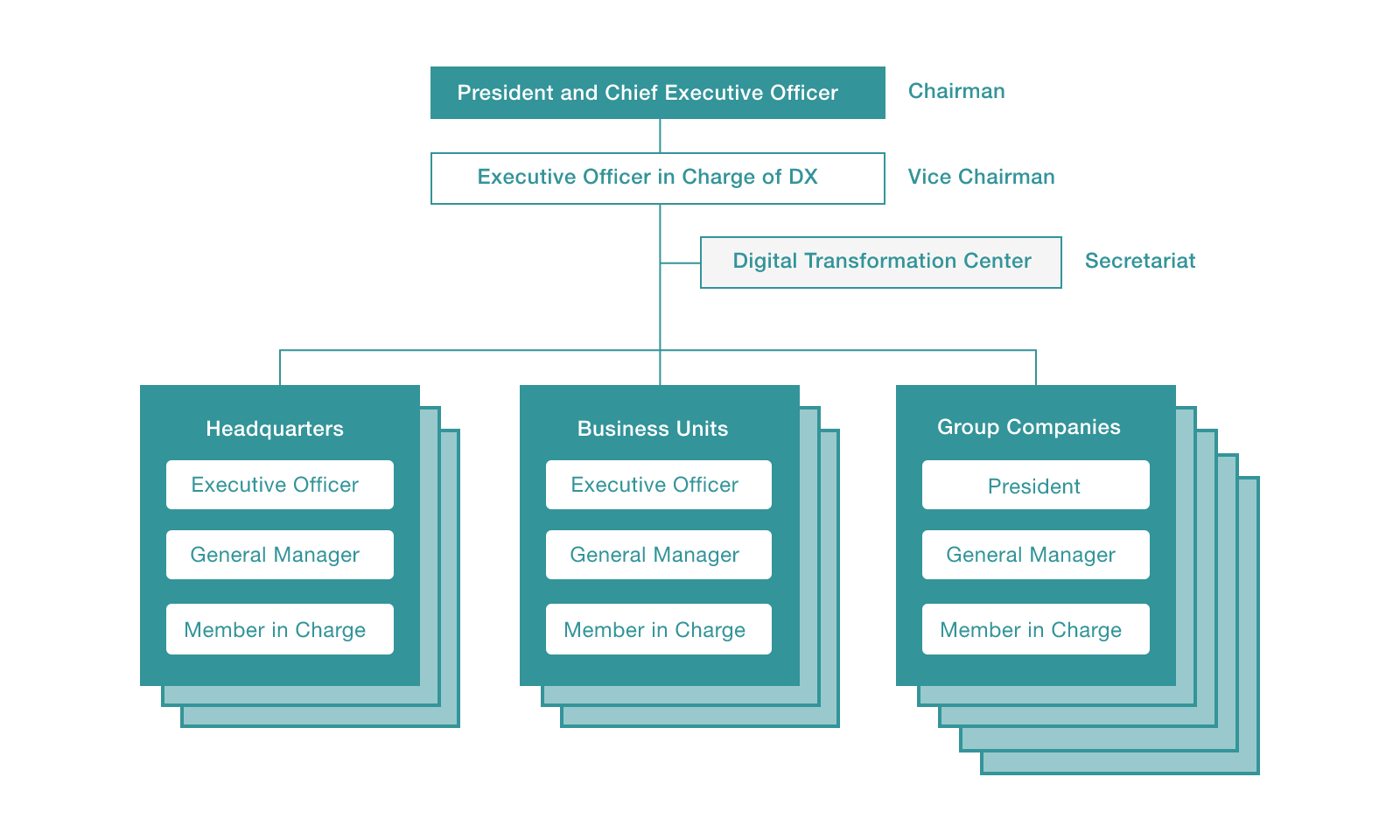Promoting DX
The Kureha Group has positioned promoting digital transformation (DX) as one of the most important measures. Based on the DX infrastructure that we have built up to date, we will enhance our corporate competitiveness by leveraging data and digital technology.
Looking back on the seven years of Kureha DX (KDX) that began in fiscal 2017, we reviewed it from a systemic perspective and established a new DX Center in our headquarters organization in April 2024. Under the strengthened organization, Kureha will work to restart its DX strategy as KDX2.0 from fiscal 2024.
Kureha's DX strategy is not just about streamlining operations through the use of digital technology, but is also about improving management decision-making, maximizing earning power, and promoting innovation by leveraging data and digital technology.
Message from Management

Further Evolve “If it doesn’t exist, make it.” with DX
Since our founding, we have pursued the philosophy of “If it doesn't exist, make it,” and we have provided new value to society with our unique technologies. In particular, our uniqueness cultivated in the fields of polymer technology and specialty chemicals is our strength.
However, today's society is changing rapidly, and environmental issues, resource constraints, and the advancement of digitalization are bringing new challenges to our business activities. To respond to these changes and remain a leader in our industry, we have positioned digital transformation (DX) as a key pillar of our management strategy.
DX is not simply the introduction of technology, but rather an initiative to revolutionize all our business activities and further evolve what makes Kureha unique. We are promoting DX based on the following three perspectives.
1. Advance our proprietary technology and improve efficiency
We will start using AI technologies with our data to streamline production sites and our research and development processes, and further advance our proprietary technology. This will improve operational quality at production sites and enable our R&D to quickly respond to market needs with new products, thereby strengthening our competitive edge.
2. Create value for our customers
We will deliver our unique value to our customers by leveraging digital technology to gain a deep understanding of customer needs for each product and providing customized solutions.
3. Strengthen our management base
We will leverage data and digital technology to evaluate capital profitability using ROIC as an indicator for each business. We will also improve transparency across the entire supply chain, starting with our main products, and promote improvements. These activities will strengthen our management base.
The promotion of DX is an important step to further evolve our philosophy of “If it doesn't exist, make it.” To achieve this, it is essential that each and every employee use digital technology and generate new value by thinking creatively. At our company, we are creating an environment that encourages employees to continue taking on new challenges, while also collaborating with external partners to accelerate DX through open innovation.
Kureha will continue to contribute to solving social issues and building a sustainable future by integrating its unique technologies with digital technologies. We promise to further evolve the essence of Kureha and deliver new value to everyone by using DX.
We look forward to your continued support of Kureha Corporation.
Vision
Kureha's DX Vision
In the spirit of "If it doesn’t exist, make it." we will continue to provide new value to our customers with unique and differentiated products by leveraging data and digital technology to improve the productivity and quality of our operations.

Management Structure
In April 2024, a Digital Transformation Center was newly established in the headquarters, and the Digital Transformation Promotion Department was made a permanent organization for the DX project we have been undertaking. It consists of the Information Systems Department and Digital Transformation Promotion Department, formulating policies for DX and IT, and unifying and coordinating the activities of both departments. If necessary, cross-organizational projects and task forces are established in the Center to solve company-wide issues.
Additionally, since October 2024, we have established the 'DX Implementation Committee,' chaired by the President and Chief Executive Officer, to strategically and efficiently execute 'DX' within our group. For each important DX theme, we have selected committee members from general managers of headquarters and business units, and presidents of group companies to monitor the progress of the DX themes and confirm the effects of business transformation and improvements in the DX themes. In addition to regular committee meetings, we will hold ad-hoc committee meetings as needed for urgent matters to ensure the alignment of DX policies and themes in our entire group.

Purpose
We have set the following defined purposes to realize Kureha's DX Vision.
-
Improve management decision-making
Support right and rapid management decisions on business strategy and resource allocation etc. by detecting anomalies (changes in data) from various systems spread throughout our entire group and quickly identifying signs of change. -
Maximize earning power
Not only eliminate unnecessary operations and reduce costs by improving work efficiency and minimizing workforce, but also increase sales and profits by creating new customers, through automation and digitization. -
Promote innovation
Promote innovation in existing operations, such as R&D and factories, through use of data and digital technology. In addition, develop an educational foundation to foster human resources capable of achieving these purposes.
Focus Areas
In accordance with the three purposes above, we have established the following seven focus areas from the perspectives of the corporate, infrastructure, and headquarters and business division topics, and are promoting them.
| (1) Corporate | |||
|---|---|---|---|
| Focus Areas | Purpose1 | Targets | FY2024 Results |
| Business management system | 1, 2 | Monitor ROIC/WACC by business unit and make appropriate management decisions. | Completed development of software to acquire financial data from the main computer system and make analysis reports visualizing ROIC by business unit. |
| Optimization of supply chain | 1, 2 | Monitor and optimize production, sales, and inventory. Detect anomalies and respond quickly. Establish an SCM improvement cycle. | Based on the KF products business, we have decided on the requirements for global PSI2 visualization and completed the development of a PSI dashboard. |
| (2) DX Infrastructure | |||
| Focus Areas | Purpose1 | Targets | FY2024 Results |
| Development of digital talent | 3 | Aim to have all employees be human resources that can reform and improve business operations with high-level use of data and digital technology. |
Redefined the types of digital talent to be developed (added business designers and IT engineers to the existing data scientists).
Created a new education system (scheduled to resume in FY2025). |
| Development of DX infrastructure | 3 | Development of infrastructure for data analytics to support data-driven management, and establishment of IT governance to standardize and integrate systems and data. | Established basic guidelines and policies for Group IT governance. Standardized gate checks for each phase from the start to the completion of IT projects, and will begin implementation in FY2025. |
| (3) Headquarters and Business Division | |||
| Focus Areas | Purpose1 | Targets | FY2024 Results |
| Digital marketing | 2, 3 | Identification of potential customers for our products, accurate understanding of customer needs, and offer of optimal customer services. |
Introduced and established a sales support system for the KF products business.
Achieved a significant increase in inquiries about our products through web marketing. |
| Materials informatics | 3 | Computational science to improve accuracy and speed up the search for new materials. | Worked on our medium-term focus area, pesticide development, and our short-term focus area, high-performance products (PGA, KF, etc.) |
| Smart factories | 2, 3 | Promotion of labor and cost reduction through factory automation, improvement of production efficiency and quality, and reduced the burden on workers. |
Digitized work instructions and reports to machine operators, significantly reducing the time required for handover and other tasks.
Introduced image analysis technology to the product inspection process. |
-
11. Improve management decision-making, 2. Maximize earning power, 3. Promote innovation
-
2Production, Sales, Inventory
Initiative(s)/Activity(ies)
Integration of ERP Systems and Operations
The Company's core systems (financial accounting, management accounting, sales management, inventory and purchase management, production management, etc.) had been optimized for each site. The core systems of domestic and Asian Group companies were integrated on the occasion of the introduction of SAP S/4HANA (as of May 2024). At the same time, simple and standardized business processes were developed and deployed to each company. This has led to standardization of data, more efficient and faster collection of consolidated management information, and enhanced management across the group.
Improvement of Business with Intelligence Tools
Business intelligence tools are distributed to each department to support the making of decisions based on data. This has allowed visualization and analysis of data in daily operations to permeate throughout the company. About 70 business applications are in operation in the areas of procurement, production, distribution, sales, and after-sales service, and the number of users is now over 600. They are now indispensable tools for business operations, and have improved operational efficiency and quality.
Enhancement and Improvement of the Efficiency of Production and Operation Management
Iwaki Factory has a number of chemical plants that manufacture our main products. With the introduction of an integrated system to manage operation information, plant operation data that until now could only be checked on-site can now be used in many departments. With this system, it has been possible to speed up the troubleshooting and equipment adjustments due to analysis of operating conditions. Also, the introduction of a system to manage operation has enabled reliable transmission of work instructions and reports, leading to a reduction of about 2,500 hours of work time over about one year since the system was introduced. In the future, we will further strengthen our analysis and improve our quality competitiveness.
Digitalization of Marketing Operations
The company is promoting digitalization in all areas of marketing, including web advertising, web page improvement, marketing automation, and the introduction of sales force automation to improve the quality and efficiency of sales promotion activities in the sales division. For particular products, the number of inquiries increased tenfold after we put advertising on the Web and other significant effects were observed. In addition, the reporting and confirmation of customer contact information has been firmly established, management within the sales department has been strengthened and streamlined, supporting daily sales activities.
Promotion of the Use of Generative AI
We see generative AI (ChatGPT) as a tool that can be applied to a wide range of internal operations and expect it to greatly improve them. We introduced a generative AI system that can be used by all employees, and began using it in December 2023. We are establishing guidelines for use of the system and are promoting its use through internal announcements. Currently, about 60% of employees are using the system in their work, and it is bringing about improvements in such areas as market research, preparation of reports and minutes, translation, and the creation of software programs.
- Sustainability
- Message from the President
- Kureha Group's Sustainability
-
Environmental Report
- Environmental Management
- Overview of Environmental Impact
- Climate Change Disclosures Based on TCFD Recommendations
- Recycling of Resources, Proper Management and Disposal of Waste
- Management of Chemical Substances, Prevention of Air Pollution, Water Use and Prevention of Water Pollution
- Conserving Biodiversity
- Social Report
- Governance Report
- Contributing to the Solution of Environmental and Social Issues through Our Business
- GRI Standards Content Index/SASB Content Index
- ESG Data Collection
- Sustainability Report Archive
- External Recognition
- Sustainability Site Editing Policy and Contents of the Report
